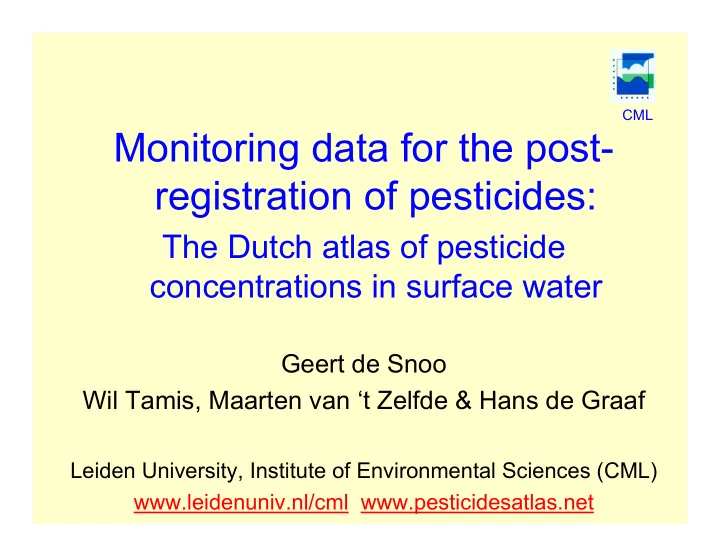

CML Monitoring data for the post- registration of pesticides: The Dutch atlas of pesticide concentrations in surface water Geert de Snoo Wil Tamis, Maarten van ‘t Zelfde & Hans de Graaf Leiden University, Institute of Environmental Sciences (CML) www.leidenuniv.nl/cml www.pesticidesatlas.net
1 Introduction: pesticide CML measurements in surface water • Many regional measurements by water authorities, however, at national level an overview lacking of: – Which pesticide is where and when a problem? – Can we use these data for pesticide re- approval?
Aim of the study CML • Where is a pesticide measured, found and exceeding a standard? • Can we improve the monitoring systems? (there is no systematic post-monitoring system) • Is it possible to link pesticide concentrations at the level of individual a.i. with land use (crop) data? (re-approval)
Set up study CML • Time – spatial analysis of existing data • Data analysis of 1999-2000 • 160 a.i., 700 locations, ± 150.000 measurements: wide variation between a.i. • Standards: – Drinking Water Standard (0.1 and 0.5 µg/l) – Max. Tolerable Risk (MTR) – Value used for the approval of the pesticide
Pesticide atlas 2004 CML • Internet application, free available – for policy makers, regulators, farmers, chemical industry, food industry & NGO’s • About 1000 maps of about 160 pesticides • Examples of linking pesticide concentrations and land use with statistics
CML
2 The pesticide atlas: meta data over time CML
No. of locations with pesticide measurements during the year CML
% locations exceeding EU drinking water during the year CML
% locations exceeding authorisation standard during the year CML
3 The pesticide atlas: geographical meta data CML Maps
No. of pesticides measured / 5x5 km CML
% of measured a.i. above authorisation standard and EU drinking water CML standard
4 The pesticide atlas: geographical data per substance CML Maps
CML Make map
CML
CML
CML
5 The pesticide atlas: CML Link with other GIS data: • Pesticide use data: hardly at a regional level available • Land use data (crops) • Geographical fate modeling • Biological datasets
EU 0.5 µg/l and arable land CML
EU 0.5 µg/l and greenhouse horticulture CML
Metribuzine (MTR) & potatoes (99%) CML ?
Correlations: Carbendazim - crops CML Flower cultivation Tree nursery Strawberries Vegetables Bulb cultivation Onions Cabbage
Predictions: carbendazim CML
6 Conclusions CML 1 Pesticide maps give relevant information: – where and when is a pesticide measured, found and exceeding a standard – Give no answers! Raising questions! 2 Regional monitoring systems can be improved for National surveys: – measurements pesticide at relevant time – measurements pesticide at relevant sites
Conclusions CML 3 Linking pesticide concentrations with land use / pesticide use data – In principle yes, specially for the a.i. used in few crops – Will be worked out in more detail using statistical tools 4 Validation of predicted risks? – Not yet done, highly interested – Concentrations at unexpected times & locations
Next step: 2004 CML • Linking pesticide concentrations and land use and pesticide use data with statistics • International setting: – English version of Dutch Atlas – International cooperation! – www. pesticidesatlas.net
www.pesticidesatlas.net CML
Recommend
More recommend